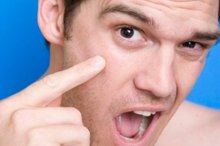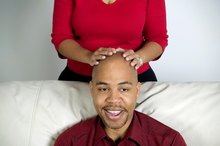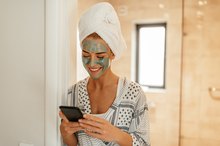What does fact checked mean?
At Healthfully, we strive to deliver objective content that is accurate and up-to-date. Our team periodically reviews articles in order to ensure content quality. The sources cited below consist of evidence from peer-reviewed journals, prominent medical organizations, academic associations, and government data.
The information contained on this site is for informational purposes only, and should not be used as a substitute for the advice of a professional health care provider. Please check with the appropriate physician regarding health questions and concerns. Although we strive to deliver accurate and up-to-date information, no guarantee to that effect is made.
Cures for Razor Bumps on the Back of the Neck
Razor bumps are a particular hazard to shaving parts of the body where hair grows out dense and coarse. For men, these typically occur on the face or the back of the neck when you're "cleaning up" the hair line around your nape. Hair follicles are attached to both oil glands and nerve endings, explains skincare expert Paula Begoun; when you shave, the physical process of razor cropping follicle irritates the skin, causing unsightly red razor bumps to emerge. There are no quick cures for razor bumps on the back of your neck, but Mayo Clinic experts and cosmetic scientists offer helpful suggestions that may work for you.
Anti-inflammatories
Begoun and the cosmetic scientists at BeautyBrains.com state that the best way to treat razor bumps is to use a topical anti-inflammatory that contains stabilized aspirin. Two products frequently mentioned are Paula's Choice Skin Relief Treatment or Tend Skin Liquid, which has a more unisex appeal.
Begoun also states that you can make your own topical home treatment. Pick up a bottle of glycerin and a bottle of aspirin from a drugstore. Crush or dissolve a couple of aspirin tablets in a quarter cup of water, thickening the solution with glycerin until you get the desired texture.
- Begoun and the cosmetic scientists at BeautyBrains.com state that the best way to treat razor bumps is to use a topical anti-inflammatory that contains stabilized aspirin.
- Two products frequently mentioned are Paula's Choice Skin Relief Treatment or Tend Skin Liquid, which has a more unisex appeal.
Persistent Razor Bumps
How to Stop Hair From Itching When Growing
Learn More
If anti-inflammatories don't cure the razor bumps on the back of your neck, both Begoun and the Mayo Clinic advise trying something a little stronger, such as an over-the-counter hydrocortisone cream to reduce itching and discomfort. If razor bumps appear to be ingrown or infected, you might have folliculitis. Mayo Clinic experts and Begoun recommend using a topical antibiotic, such as Neosporin, Polysporin or Bacitracin.
Exfoliation
Razor bumps typically resolve on their own if you give your skin and follicles time to recuperate. But when ingrown hairs occur—when the follicle grows back toward the follicle, resulting in clusters of small, solid or pus-filled bumps—you can release the hairs by gentle exfoliation 1. Mayo Clinic experts advise taking time out twice a day to wash your neck either with a washcloth or a soft-bristled brush. Use circular motions for a couple minutes before you go to bed and each time before you shave. If signs of infection are present, Mayo Clinic experts advise using an antibacterial soap whenever you wash, making sure that you use a clean washcloth and towel.
- Razor bumps typically resolve on their own if you give your skin and follicles time to recuperate.
- If signs of infection are present, Mayo Clinic experts advise using an antibacterial soap whenever you wash, making sure that you use a clean washcloth and towel.
Other
How to Get Rid of Stitch Scars on the Face
Learn More
The most effective cure for razor bumps is to change the way you shave so you can avoid them. One option is to use an electric razor, which doesn't crop the hair as closely as a conventional shaving tool. But if you want to continue to shave, Mayo Clinic experts advise using a single-bladed razor. Dampen the skin with warm water before applying a lubricating shaving cream. Shave in the same direction of hair growth, rather than against it, taking time to rinse the razor after each stroke. Apply a moisturizing aftershave after rinsing your skin well.
- The most effective cure for razor bumps is to change the way you shave so you can avoid them.
- One option is to use an electric razor, which doesn't crop the hair as closely as a conventional shaving tool.
Related Articles
References
- Mayo Clinic: Treating Ingrown Hairs
- Mayo Clinic: Treating Folliculitis
- Beauty Brains: Treating Ingrown Hairs
- Gray J, McMichael AJ. "Pseudofolliculitis Barbae: Understanding the Condition and the Role of Facial Grooming." International Journal of Cosmetic Science. 2016;38 Suppl 1:24-27.
- Zaenglein AL, Pathy AL, Schlosser BJ, Alikhan A., Baldwin HE, Berson D, et. al. "Guidelines of Care for the Management of Acne Vulgaris." Journal of the American Academy of Dermatology. 2016;74(5):945-973.
Writer Bio
Lisa Sefcik has been writing professionally since 1987. Her subject matter includes pet care, travel, consumer reviews, classical music and entertainment. She's worked as a policy analyst, news reporter and freelance writer/columnist for Cox Publications and numerous national print publications. Sefcik holds a paralegal certification as well as degrees in journalism and piano performance from the University of Texas at Austin.









